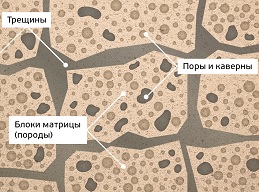- Home page /
- New technologies and equipment /
- Gazprom Neft selects technologies for working with a new...
Gazprom Neft selects technologies for working with a new class of deposits
 |
| Courtesy of gazprom-neft.com |
Gazprom Neft has developed a programme for implementing new oil production technologies in carbonate and fractured reservoirs* — a category which includes more than 40 percent of the company’s recoverable reserves, or almost 600 million tonnes of hydrocarbons. The project is being implemented as part of the company’s Technology Strategy.
Approximately 40 percent of the remaining reserves throughout Gazprom Neft’s fields are located in carbonate reservoirs. The most significant assets containing such deposits include the eastern part of the Orenburg field, the Kuyumbinskoye and Chonsky fields in Eastern Siberia, the Badra project in Iraq, and the Prirazlomnoye field on the continental shelf of the Pechora Sea. In terms of global hydrocarbon reserves, carbonate reservoirs play an ever more significant role — the majority of new fields falling into precisely this category.
The features of carbonate reservoirs require high-level skills and competencies on the part of oil engineers, as well as the appropriate selection of technologies in order that development is as effective as possible. The new programme has been developed by the Gazprom Neft Joint Scientific and Research Centre, and includes 12 technological initiatives in geological prospecting, field development, well boring, and oil production. Implementation of these will lead to a better understanding of the “behaviour” of carbonate reservoirs under development and, subsequently, increase the efficiency of oil production from these. In particular, enhanced oil recovery (EOR) techniques for carbonate reservoirs are to be introduced at the Chonsky project in Eastern Siberia, the pores of which are often clogged with salt, meaning the oil cannot pass through. Selection of acid-fracturing technologies is currently ongoing at the Kuyumbinskoye field, and technological solutions directed at identifying regimes for optimum well operation are in hand at the Orenburgskoye field.
Vadim Yakovlev, First Deputy CEO, Gazprom Neft, commented: “Gazprom Neft’s technological development means we can be confident in increasing production, and the efficiency thereof. But in order to maintain that momentum we must, today, develop those technologies we plan to use tomorrow. The complex geology of carbonate reservoirs has not, until recently, allowed us to ensure their full development; today, we are, already, working with part of our own complex reservoirs, and I have every confidence that, as a result of these new technologies, their share as a proportion of the company’s total production is going to grow”.
* Most oil — in Russia and worldwide — is produced from terrigenous deposits (i.e., deposits derived from land as opposed to marine environments). These kinds of reservoirs are made up of decomposed geological material, are well understood, and typically have a high degree of predictability in terms of their development. Carbonate reservoirs, in contrast, are typically formed in situ from the growth of marine organisms, or are the result of sediments deposited by water. Oil deposits in carbonate reservoirs are often former coral reefs. Carbonate reserves are formed as a result of a reaction of the minerals present in water, causing a significant change to the underlying geology, and resulting in highly erratic reservoir properties. A reservoir may be highly porous, but pores may not necessarily be connected to each other, so that the strata are practically impenetrable in allowing hydrocarbons to flow into a well. These reservoirs also have a further feature — a large number of fissures, demanding a particular approach in their development. For example, gas or water can get into oil-bearing strata through these fissures, with an adverse effect on the oil production process.
The effective development of such fields demands the use of innovative approaches covering many areas, including petrophysical modelling and core analysis, extensive specialist geological investigations, innovative approaches to hydrodynamic (flow) stimulation, and more. As part of its Technology Strategy Gazprom Neft is studying the scientific and engineering experience it has accumulated in various areas — including geophysical investigations and data integration, geo-mechanics, modelling, hydrodynamic investigations, well operation regimes and EOR techniques — and adapting these to its own projects.
Source: gazprom-neft.com

